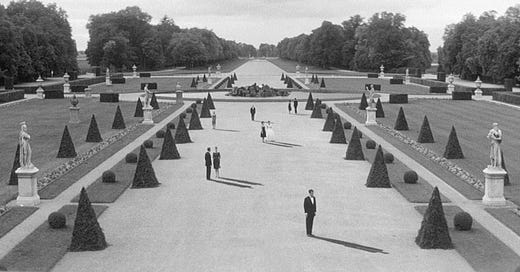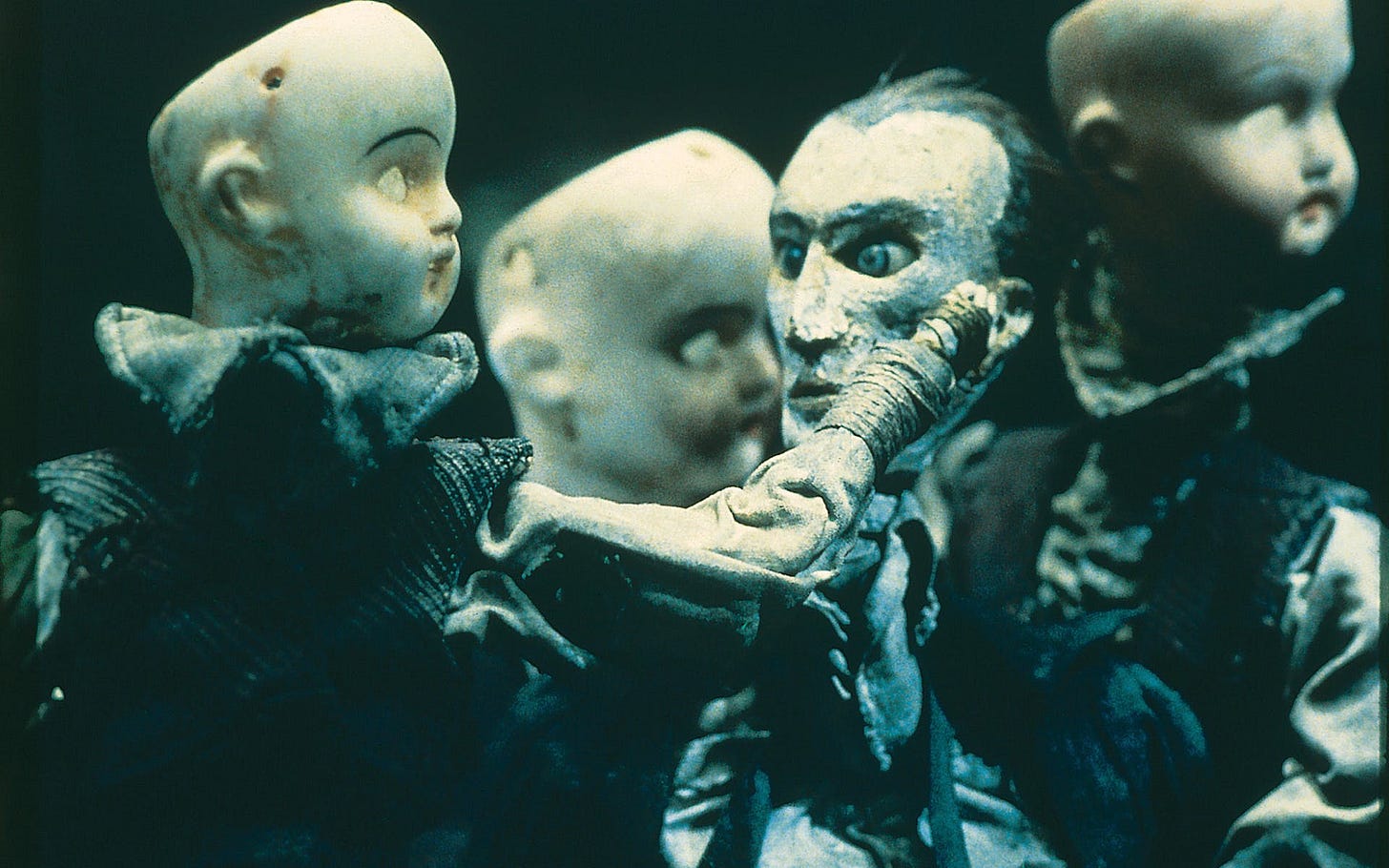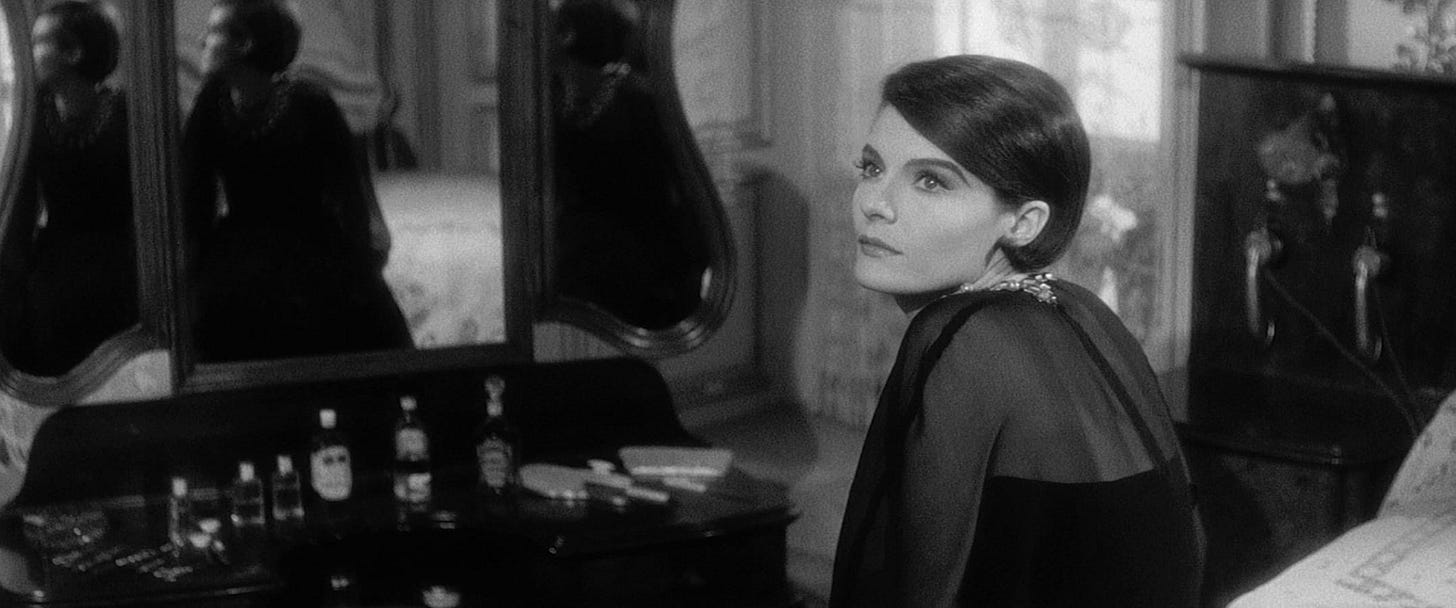Last Year in Marienbad (1961, Alain Resnais) + Street of Crocodiles (1986, Brothers Quay)
Tuesday 8th of April, 6:45pm in the Richard Hoggart Building Cinema
Join us on Tuesday the 8th of April from 6:45pm (films start at 7pm) in the Richard Hoggart Building Cinema for the first screening of our summer programme: Alain Resnais’s Last Year in Marienbad (1961), which will be preceded by a short film by the Brothers Quay, Street of Crocodiles (1986). The latter is 21 minutes long, finishing around 7:21pm. Last Year in Marienbad will begin at 7:25pm and lasts 1 hour 34 minutes, finishing at 9pm.
Loosely adapted from the stories of Polish modernist writer and artist, Bruno Schulz, Street of Crocodiles exemplifies the immediately recognisable and singular aesthetic language of the Brothers Quay. Deeply metaphorical, the short film embodies the mythopoetics of Schulz, while taking inspiration from Walter Benjamin and Sigmund Freud to formulate a distinctly filmic and psychological approach. The film was included by Terry Gilliam in his list of the ten greatest animated films of all time.
From Sarah Scott for Senses of Cinema:
The Street of Crocodiles both recovers and mocks childhood, and our adult memories of childhood, in a grotesque, fetishistic manner, raising questions about the relationship between animation, modernity and the child’s place within this inanimate, inhuman world of technological progress. These processes of the organic and non-organic object relate directly to the technicality of the animated form within cinema and film theory’s often blind refusal to recognise that animation, in its broadest sense, captures not only the essence of the uncanny in film but the essence of the cinematic apparatus. If I have argued here for the “filthy” quality of age through the morbid æsthetics of the film, then ultimately what I have tried to show is the way in which animation makes explicit the ghostliness of technology and our way of perceiving the animated world on film. The fragmentary nature of The Street of Crocodiles inevitably causes some difficulty in adequately describing its intertwining æsthetic and formal aspects. Yet it is the fragmentary nature of human development, memory and language that reflects the fragmentary world of Benjamin, Schulz and the Brothers Quay. It would therefore seem relevant not to upset the miniature world of allegorical play, but to let it continue to animate the dust-covered streets that belong the mechanics of the cinema.
For the Walker Art Gallery, by Tom Schroeder:
At a certain age I became preoccupied with the trivialities of adolescence and abandoned my search for these cloistered spaces.
And then, unexpectedly, in my early twenties, having forgotten my mild obsession with gaining access to these rooms, I was shown the door. The strings confining the main puppet character in Street of Crocodiles were cut and, moments later, a glass wall ceremoniously lifted. I’m a compulsive film enthusiast, and I’ve had quite a number of overwhelming reactions to particular films over the years, but this first encounter with the Brothers Quay was a uniquely physical experience.
I would call it more of an ordeal than a viewing.
I cried and held my arms across my chest. I had difficulty breathing. I experienced the most peculiar sensation of having been turned inside out, that something intimate and particularly private to me was being made publicly manifest. It was as if I were the film projector thinking the film into being–the barely conscious, half-forgotten shadows of my fluid childhood sensitivities laid bare upon the screen. The Brothers Quay had revealed the secret internal space I once had sensed so strongly, and it was, strangely, a suspension between place and thought, simultaneously metaphorical and physical.
In Last Year at Marienbad, with a screenplay written by Nouveau Roman pioneer Alain Robbe-Grillet, mysteries abound at a party in an unreal mansion, where a man and a woman disagree over whether they have met before. The film’s enigmatic quality has confounded as many viewers as it has entranced, with critics such as Pauline Kael hounding it for pretentiousness and incomprehensibility, whilst its admirers praise a not dissimilar quality. “Let’s get one thing straight”, said Robbe-Grillet in answer to questions over the truth behind the film’s narrative: “these questions have no meaning.” What is generally agreed upon is the film’s formal mastery and its intensely allusive texture; though with Last Year at Marienbad, Resnais turned away from more ‘serious’ topics such as the Holocaust and the Atom Bomb, his engagement with the workings of memory is as paradoxically subtle and prominent as ever in the film, and its hypnotic beauty has ensured its lasting place in cinematic history: “it is Marienbad […] that has long since become emblematic of not just Resnais’ career, but the experiments of the nouveau roman and 1960s European art cinema as a whole.”
From Criterion:
Not just a defining work of the French New Wave but one of the great, lasting mysteries of modern art, Alain Resnais’ epochal Last Year at Marienbad (L’année dernière à Marienbad) has been puzzling appreciative viewers for decades. Written by radical master of the New Novel Alain Robbe-Grillet, this surreal fever dream, or nightmare, gorgeously fuses the past with the present in telling its ambiguous tale of a man and a woman (Giorgio Albertazzi and Delphine Seyrig) who may or may not have met a year ago, perhaps at the very same cathedral-like, mirror-filled château they now find themselves wandering. Unforgettable in both its confounding details (gilded ceilings, diabolical parlor games, a loaded gun) and haunting scope, Resnais’ investigation into the nature of memory is disturbing, romantic, and maybe even a ghost story.
For more on the film, see Mark Polizzoti’s essay for the Criterion release.




